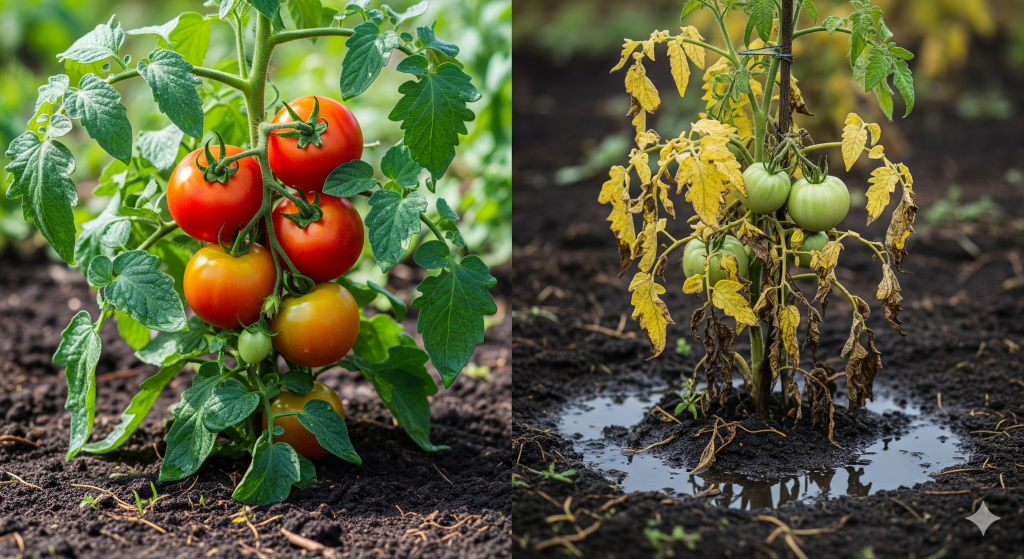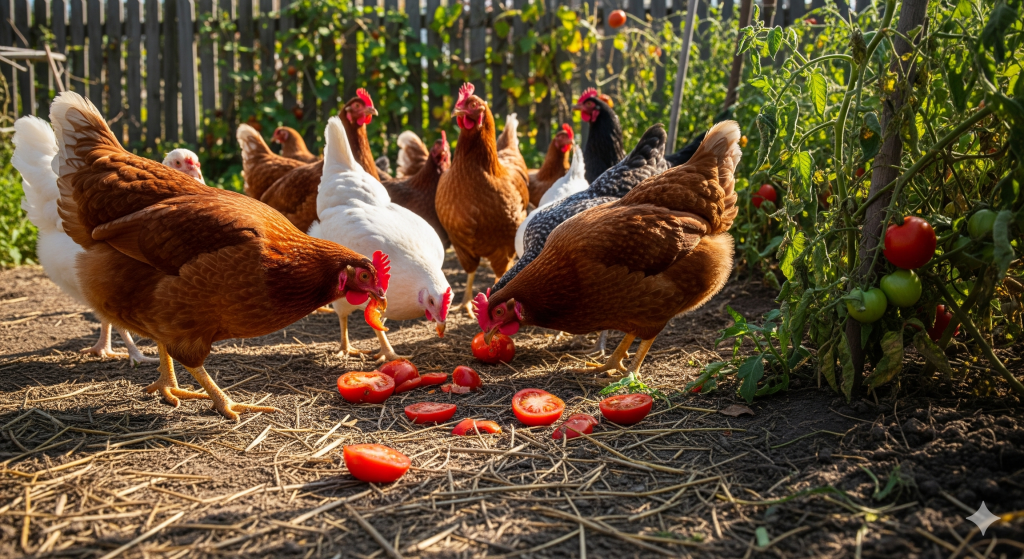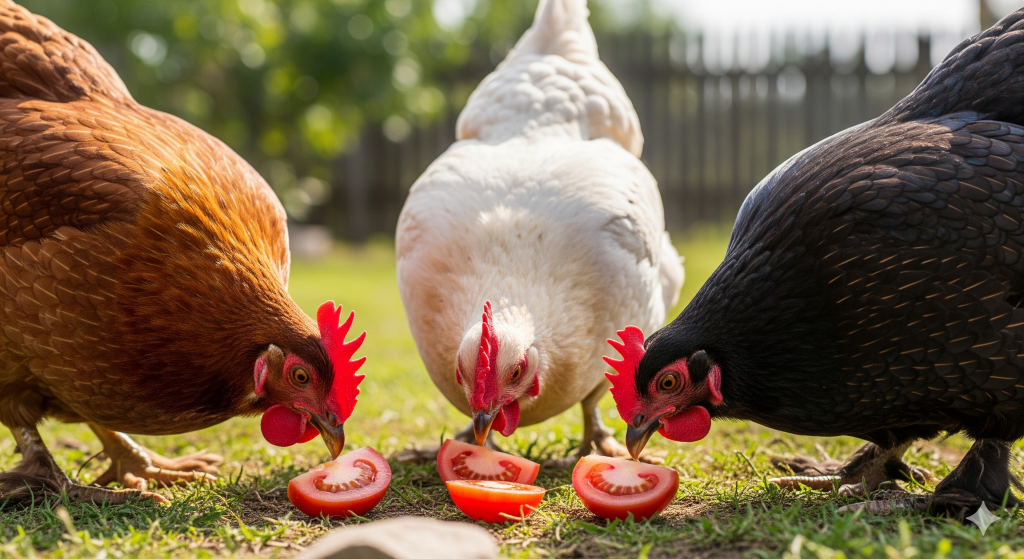Table of Contents
For every gardener, from the novice with their first patio pot to the seasoned expert with sprawling garden beds, mastering the art of watering is fundamental to success. When it comes to a thirsty crop like tomatoes, it’s natural to want to provide plenty of moisture. This leads to a critical question: “Can you water tomato plants too much?” The answer is an emphatic yes. In fact, overwatering is one of the most common and damaging mistakes a gardener can make, often causing more harm than not watering enough.
Tomatoes thrive on consistency, not excess. While they need a steady supply of water to produce juicy, delicious fruit, providing too much can lead to a host of problems, from root suffocation to fungal diseases, ultimately jeopardizing the health and productivity of your entire plant. Understanding the fine line between perfectly hydrated and dangerously waterlogged is key to a bountiful harvest.
Ready to Take Your Self-Sufficiency to the Next Level?

If you love the self-sufficient lifestyle, this is the only guide you’ll ever need. Learn how to generate your own power, secure your water supply, and become truly independent. No fluff, just actionable plans.
➡️ Check out The Self-Sufficient Backyard and start your journey today!
Is Too Much Water Bad for Tomato Plants?
Yes, too much water is incredibly bad for tomato plants. Their roots, just like the rest of the plant, need to breathe. The tiny air pockets in healthy soil provide the oxygen that roots require to function, absorb nutrients, and sustain the plant.
When you overwater, these air pockets become filled with water. This waterlogged environment effectively suffocates the roots, leading to a condition known as root rot. Damaged or rotting roots are unable to absorb water and nutrients, which, ironically, can make an overwatered plant look just like an underwatered one. Furthermore, constantly damp conditions create the perfect breeding ground for fungal diseases like blight, root rot, and verticillium wilt, which can quickly devastate a tomato crop.
Signs of Underwatering Tomato Plants
An underwatered tomato plant sends out very clear distress signals. The problem is easily identifiable and, if caught early, very easy to fix.
The most obvious sign is wilting leaves, especially during the hottest part of the day. The leaves will look droopy, limp, and lifeless. The soil will be visibly dry, cracked on the surface, and pulling away from the sides of a pot. Other signs include dry, brittle, or yellowing lower leaves and stunted growth. Fortunately, a deep, thorough watering will usually cause a wilted tomato plant to perk up within a few hours.
Image of an underwatered tomato plant:
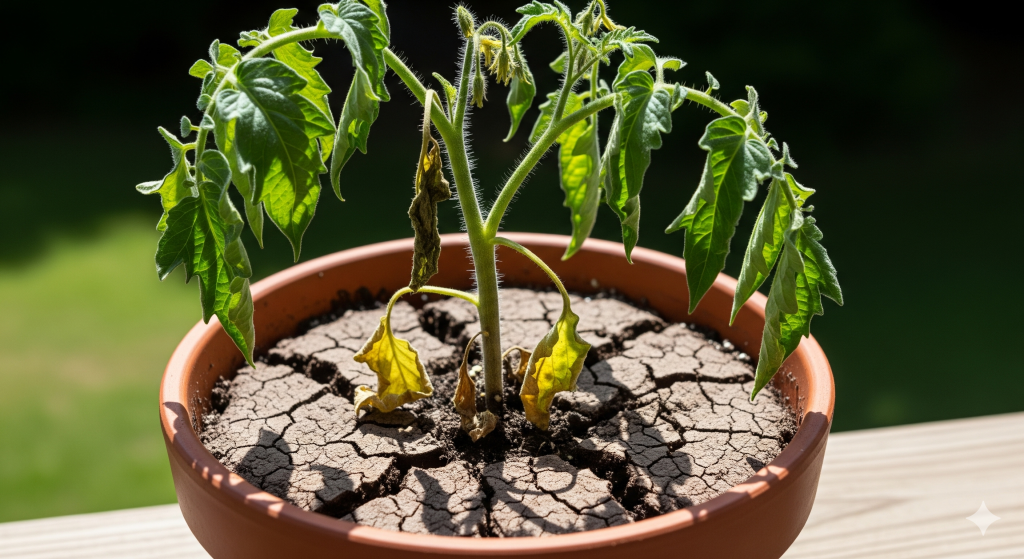
Signs of Overwatering Tomato Plants
The signs of overwatering can be more subtle at first but are far more dangerous to the long-term health of the plant. Because the roots are suffocating, they can’t deliver water to the leaves, leading to symptoms that can be confusingly similar to underwatering.
Key signs include yellowing leaves, starting with the lower ones, and stunted or slow growth. The soil will be consistently soggy or muddy, even days after watering. In pots, the soil may feel heavy and water might pool on the surface. You might also notice small bumps or blisters (edema) on the leaves, especially the undersides, or a musty, rotting smell from the soil, indicating root rot has set in. Unlike an underwatered plant, an overwatered one will not perk up after more water is applied.
Image of an overwatered tomato plant:
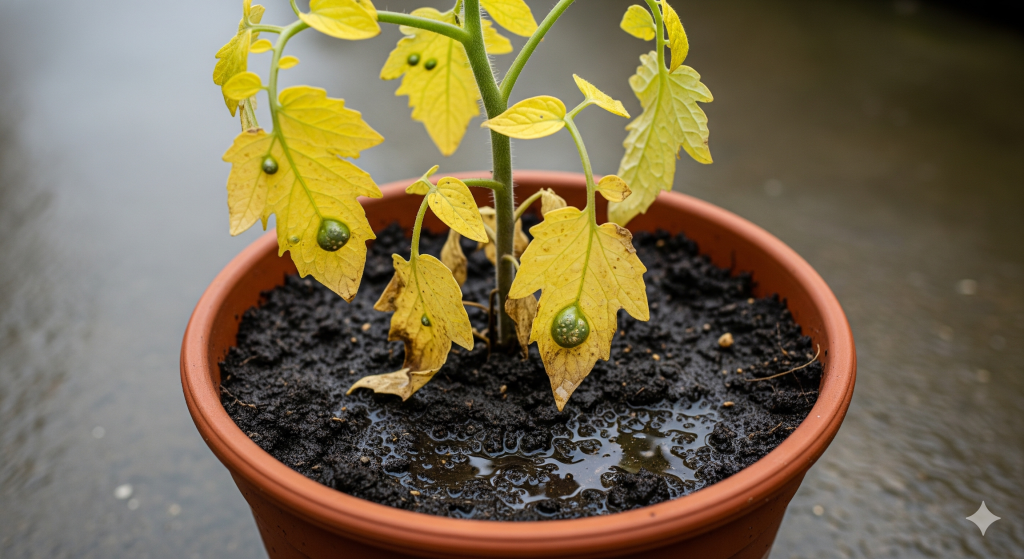
Can Overwatered Tomato Plants Be Saved?
Yes, an overwatered tomato plant can often be saved, but you must act quickly. The chances of recovery depend on how long the plant has been waterlogged and whether significant root rot has occurred.
Here are the steps to take:
- Stop Watering Immediately: This is the most crucial first step. Do not add any more water to the already saturated soil.
- Assess the Drainage: Ensure your pot has plenty of drainage holes. If you suspect they are clogged, gently tip the pot and clear them. For garden beds, the issue might be heavy, compacted clay soil. You may need to gently aerate the soil around the plant with a garden fork once it dries slightly.
- Allow the Soil to Dry: Give the soil time to dry out completely. This could take several days. Do not water again until the top 2-3 inches of soil are dry to the touch.
- Prune Damaged Leaves: Carefully prune away any yellowed or dead leaves and stems. This will help the plant redirect its energy toward recovering and producing new, healthy growth.
- Consider Repotting (for containers): If root rot is severe (you’ll know by the slimy, dark roots and foul smell), your last resort is to gently remove the plant from its pot. Trim away any dead or rotting roots with sterile scissors and repot it in fresh, well-draining potting mix. This is a drastic step and will cause further shock, but it can be necessary to save the plant.
Conclusion
Water is the lifeblood of a tomato plant, but as with many things, there can be too much of a good thing. Overwatering poses a significant and often insidious threat, leading to root suffocation, disease, and a plant that, ironically, can’t get the water it needs. By learning to recognize the distinct signs of both overwatering and underwatering, you can better diagnose your plant’s needs. The golden rule is to always check the soil before you water. Aim for consistently moist soil, not perpetually soggy soil. By finding this crucial balance, you provide your tomato plants with the ideal conditions to thrive, ensuring a healthy root system and a delicious, bountiful harvest.

